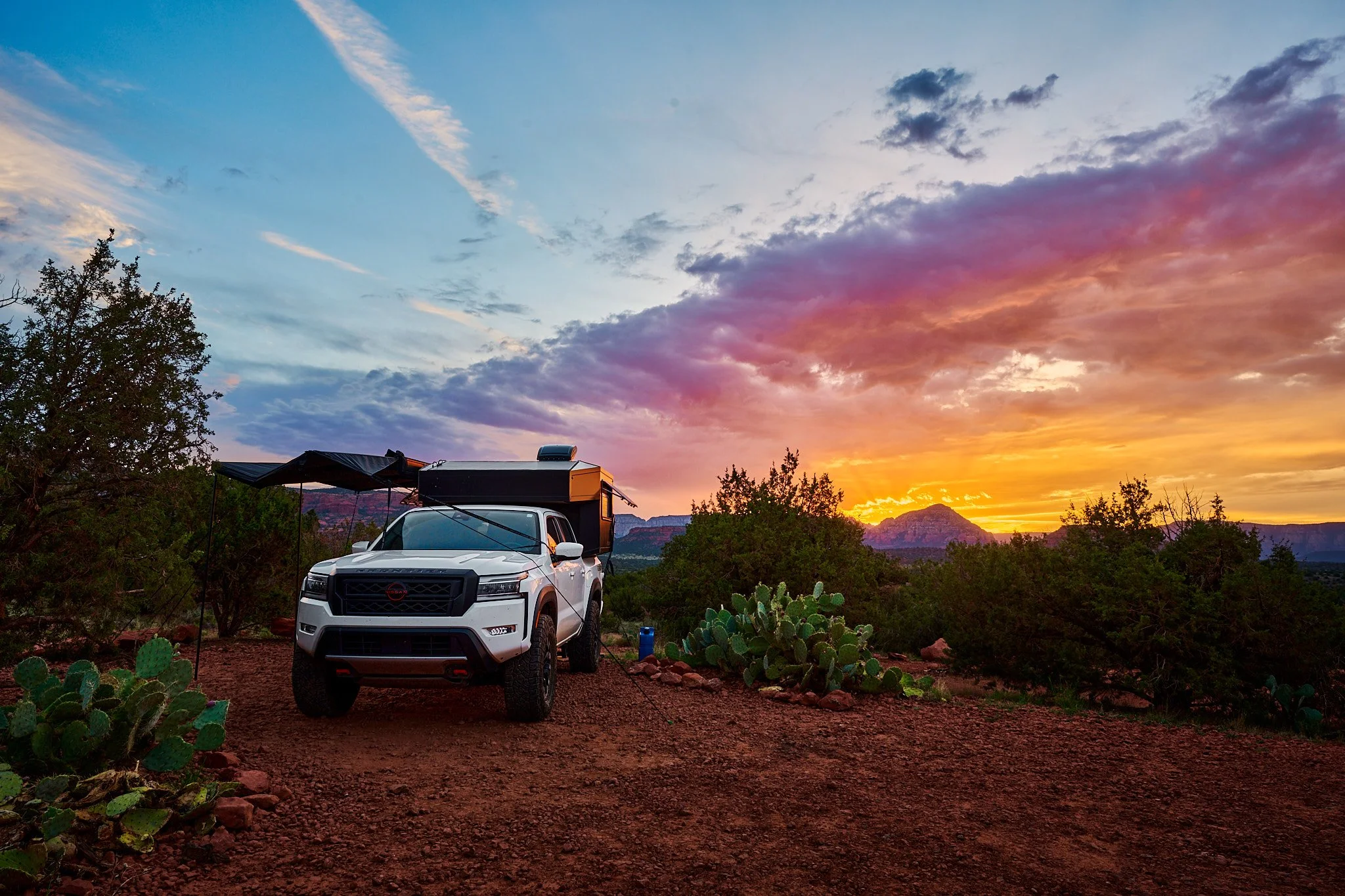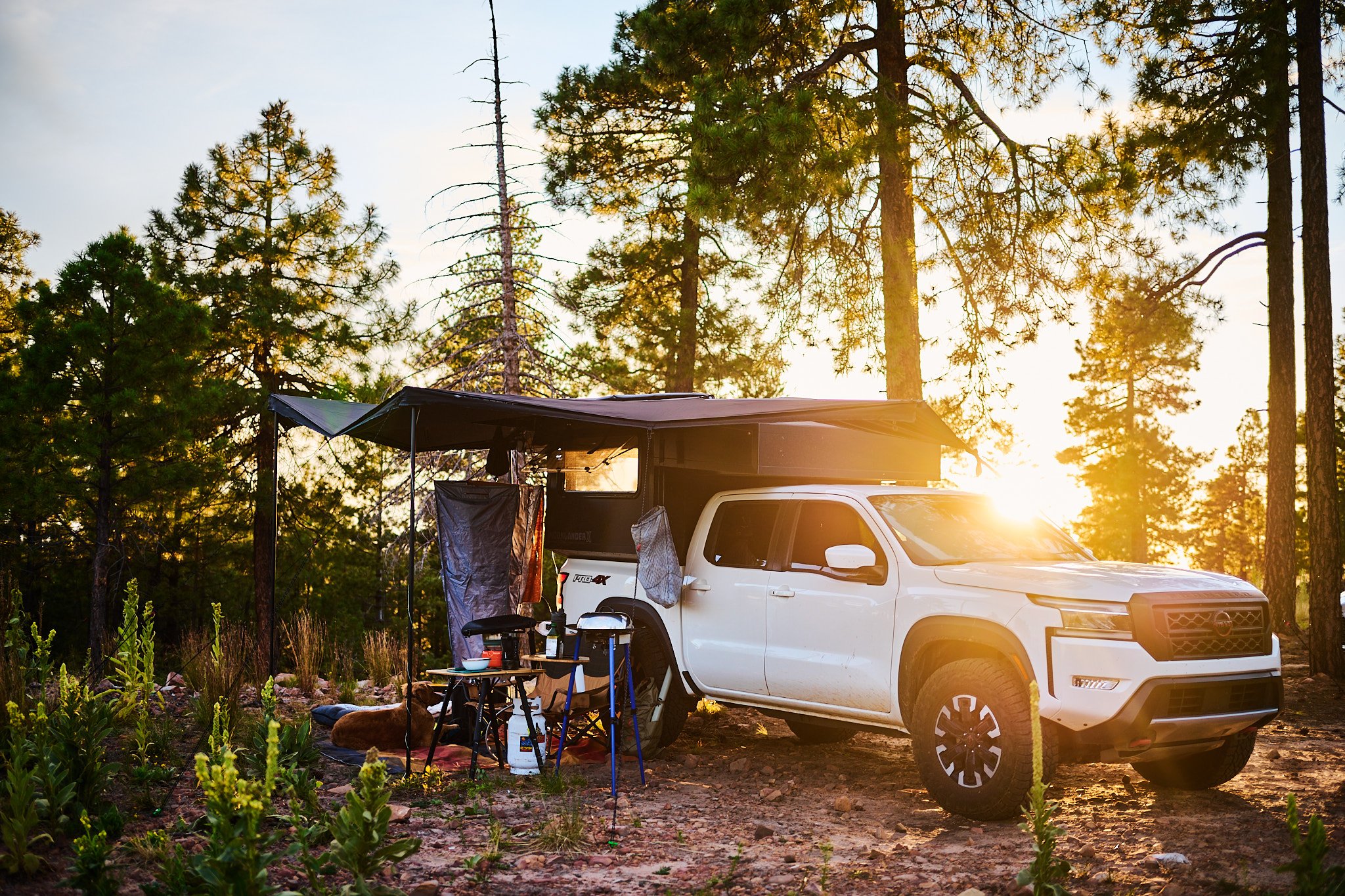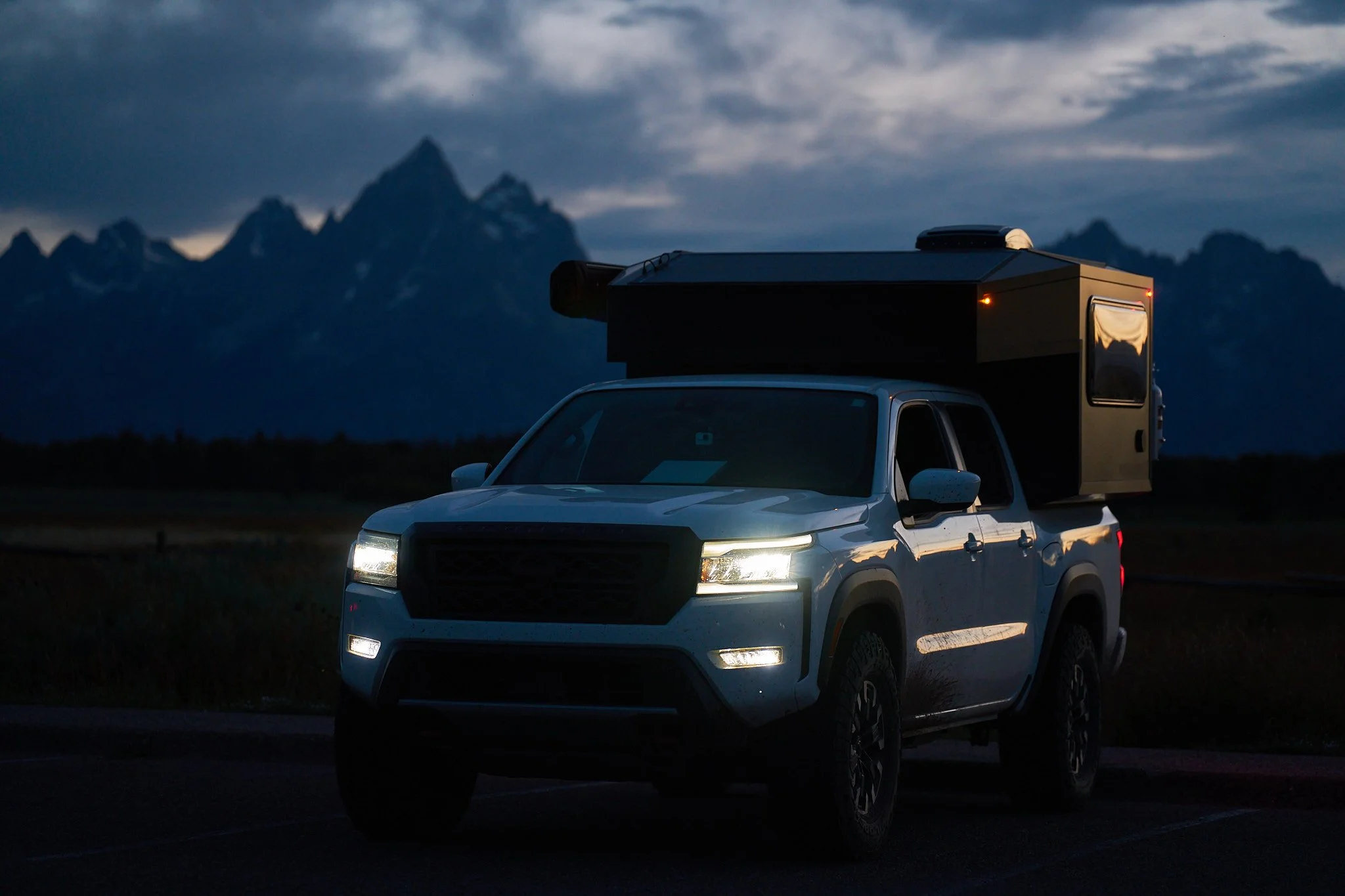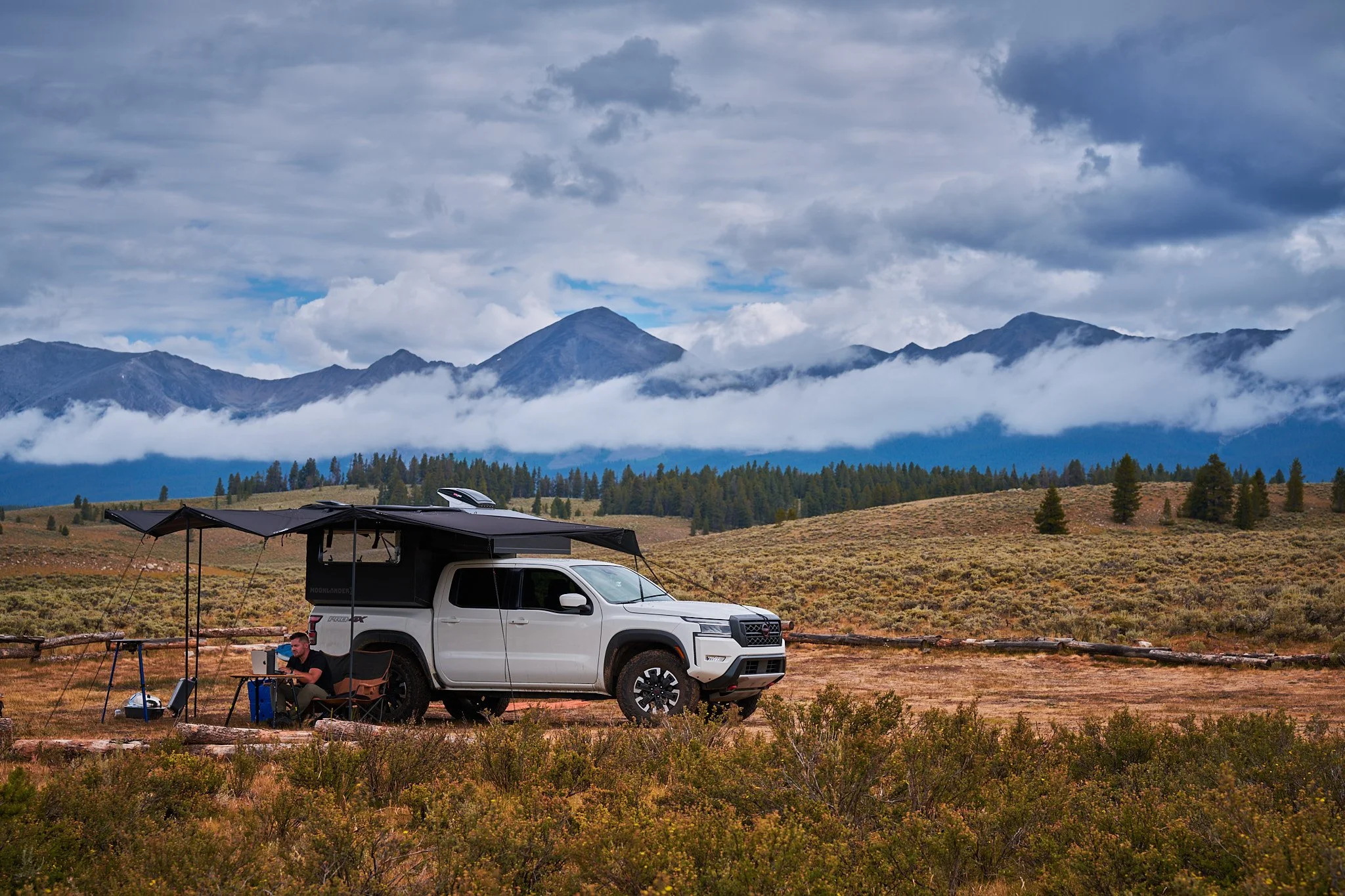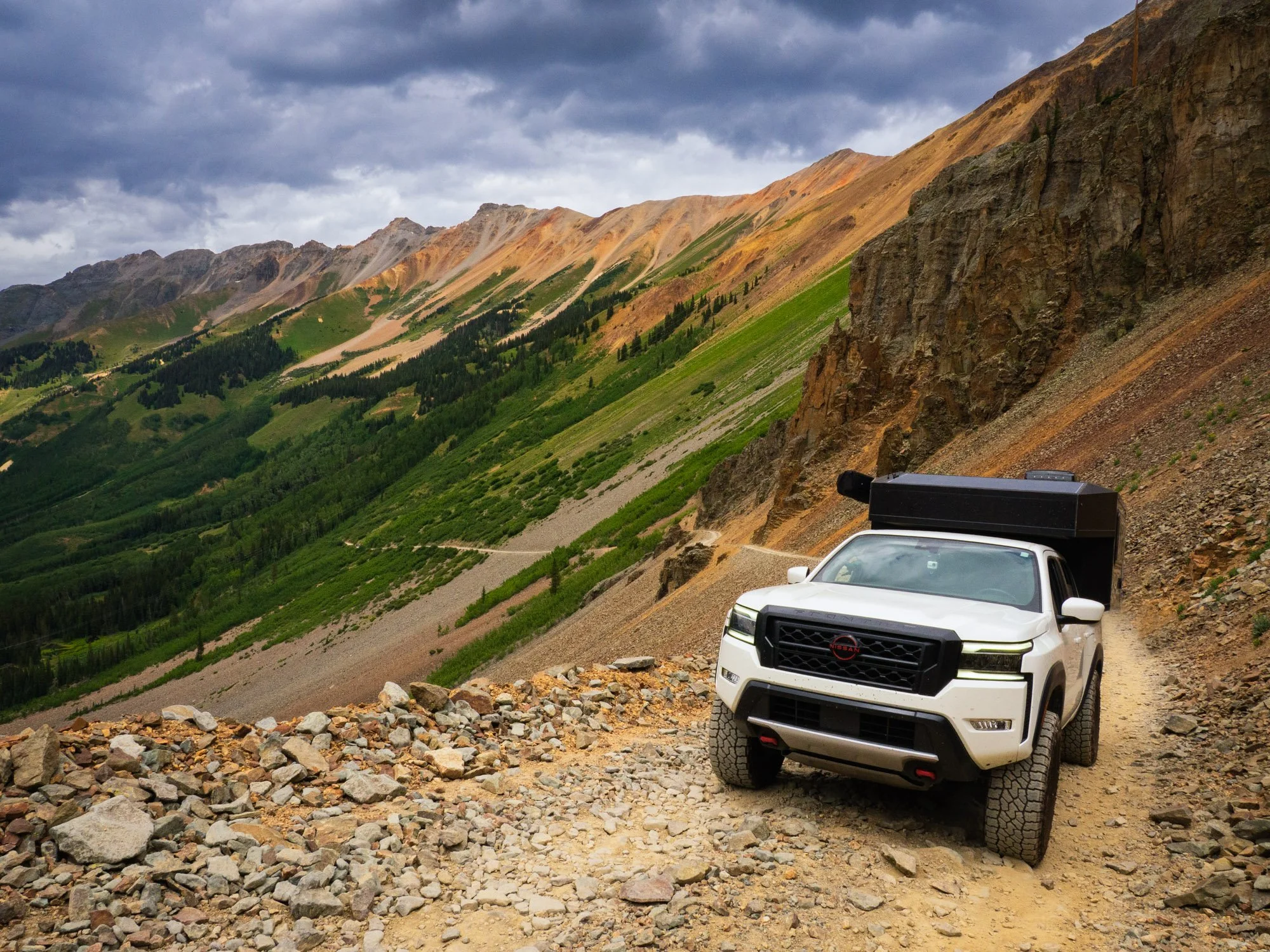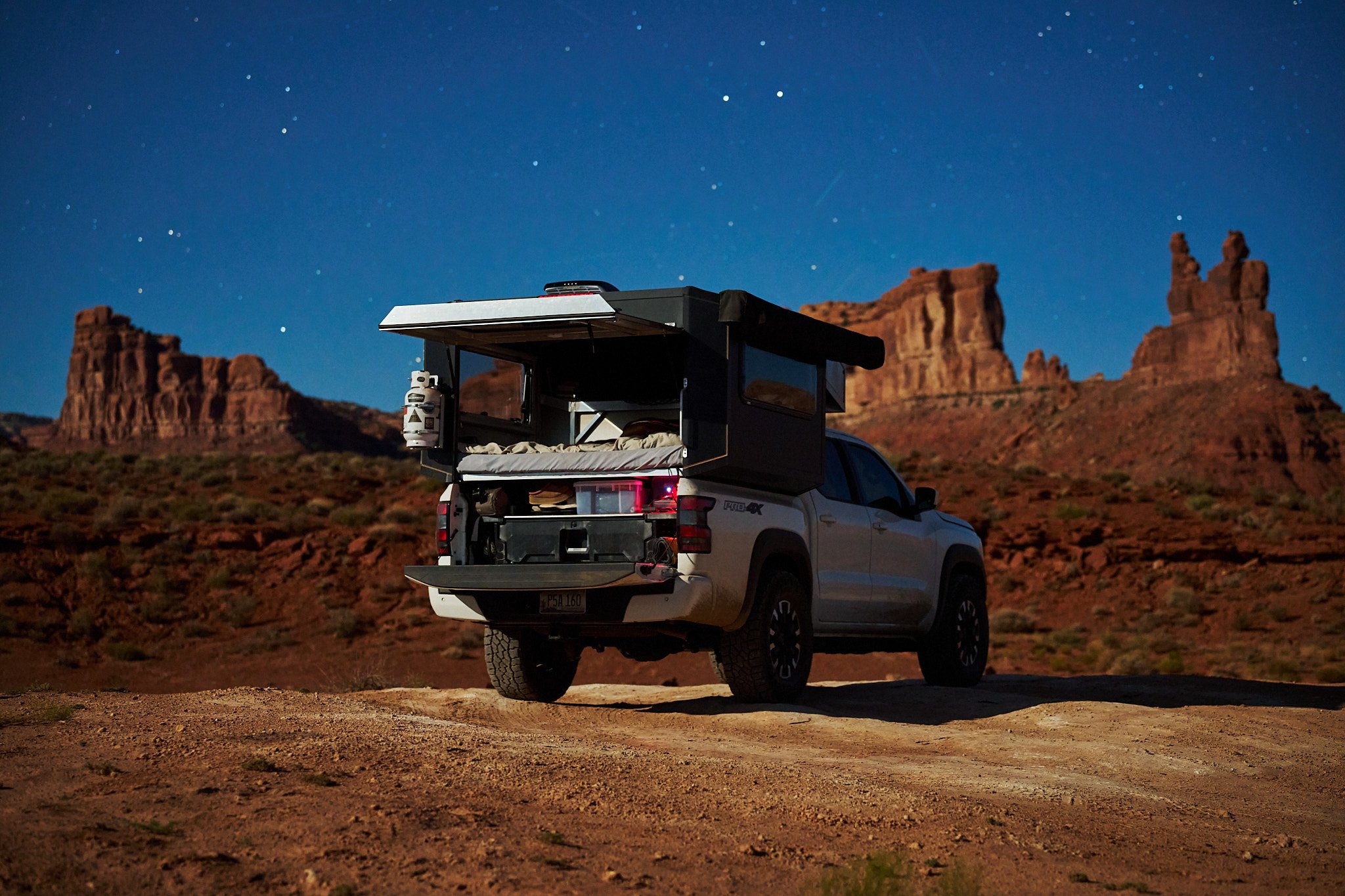Fall Color in the San Juans
Story
After three weeks away from the channel, I packed the truck and headed north—chasing peak fall color through the San Juan Mountains. The route carried me from the heat of Phoenix to the cool air above Flagstaff, where I spent the first night camped beside Marshall Lake. From there, I climbed higher into Colorado, past Durango and Silverton, until the peaks around Ouray and Telluride were drenched in gold.
Every turn of the Million Dollar Highway looked like a painting come to life. The aspens were at their brightest—yellow, copper, and green blending into the kind of fleeting beauty you only get once a year. Near Ironton, I found quiet camps among the trees and spent hours filming light breaking through the mist.
At Last Dollar Overlook above Telluride, the calm shifted. Storms moved in fast—dark clouds, thunder, wind, and rain pounding the camper late into the night. I sat inside the Moonlander listening to the storm tear across the ridge, the truck rocking with each gust. It was one of those moments that reminds you what it takes to live this way: the balance between freedom and exposure, between control and surrender.
Reflection
People talk about the freedom of the open road, but rarely about the cost.
Running KPL Studios while keeping This Way Wild alive means constantly moving between two worlds—client calls and deadlines on one side, solitude and stillness on the other. When I’m away from the road too long, I feel it. The rhythm shifts, and so does the clarity that comes from being out here.
This trip reminded me that balance isn’t about control—it’s about rhythm. Seasons change, work ebbs and flows, and every time I return to the road, I’m reminded of what’s worth keeping and what’s worth letting go.
Watch the Episode
🎥 Watch Episode 09 — Chasing Fall in the San Juans
A fall color journey through the San Juans—from quiet mornings near Ironton to storm-soaked nights above Telluride.
Gear + Partners
Partners
Gear Featured
Sony A7S III • DJI Air 2S • Insta360 GO 3S + X5
The Dyrt (campsite finder) • Fall Foliage Tracker (fallfoliage.smokymountains.com)
Rig Build
2024 Nissan Frontier Pro-4X • Radica Moonlander X • Goal Zero + EcoFlow Dual Power System • OVS XD 270° Awning • Tembo Tusk Skottle • Starlink Mini • Maxxair Fan • DECKED Drawer System
Links
This Way Wild — thiswaywild.com
KPL Studios — kplstudios.com
Learning to trust the process
West Sedona — Monsoon Afternoons & Red Rock Evenings
Sedona sits at about 4,360 feet in elevation and is famous for its towering red sandstone formations — part of the Schnebly Hill Formation, whose deep color comes from oxidized iron. I found a quiet camp spot in West Sedona where the mesas framed the horizon, and every evening felt like witnessing a painting being created.
The monsoon sky built itself like clockwork. Puffy clouds turned to thunderheads, lightning flashed miles away, and the desert air shifted just before the first drops hit. Then the sun broke through and turned the red rock into a glowing canvas of gold, pink, and orange.
Staying in one place for several nights gave me the space to exhale and notice how it felt to trust the setup again — to trust that the fridge would stay running, the power would hold, the rig would start when I turned the key. That trust made it easier to stay still, to sit outside through a storm, to let the sky finish its painting before packing anything away.
Rim Road 300 — Life on the Edge of the Plateau
After Sedona, I climbed east to Rim Road 300, a winding dirt road that hugs the Mogollon Rim — the dramatic southern edge of the Colorado Plateau. The Rim stretches nearly 200 miles across Arizona, topping out around 8,000 feet. Up here the air changes — cooler, pine-scented, thin enough to notice when you breathe deep.
I set up camp facing a south-facing drop-off, with sweeping views over the valley. Each morning I woke to a sunrise that poured straight into camp, reminding me to slow down before the day rushed in. Trust, again, was the quiet theme. Trust that the gear was dialed. Trust that staying put was the right move. Trust that slowing down wouldn’t cost me anything I couldn’t get back.
The hike to Bear Canyon Lake was the perfect punctuation. The trail was quiet, pine needles soft underfoot. When the lake came into view, it was perfectly still — and for the first time in weeks, I felt the same way.
Why It Matters
This episode was about more than two locations — it was about rebuilding confidence. Sedona and the Rim offered the perfect places to test that: red rock storms and pine forest mornings reminding me that trust takes time.
Trust that the systems will work.
Trust that the road will hold me.
And maybe most importantly, trust that I can slow down and let it.
Trust takes time — and I’m learning to be patient with my investments, with my gear, and with myself. Episode 07 feels like the first chapter in a new pace for the road ahead.
Adventure Garage to the Rescue
Wrench Time in the Valley
This episode opens with a trip back to River Outdoors’ Adventure Garage in Phoenix — their shop where all the work on my Moonlander comes together. The Frontier rolled in dusty, tired, truly broken, and by the time we were done, it rolled out better than new.
We ditched the broken awning and bolted on a fresh replacement. The batteries came out, got new custom mounting hardware, and went back in solid. The wiring got stripped, rerouted, and tightened down until the whole setup was dialed. We even added charge ports right next to the Anker EverFrost fridge so I could stop running cords across the truck bed.
I stress-tested everything before leaving: ran the batteries hard, cycled the fridge, flipped lights on and off just to see them work. For the first time in a while, I didn’t have to cross my fingers or constantly check everything a second or third time.
A Conversation with Louie
While the truck was getting buttoned up, I sat down with Louie from River Outdoors for a quick interview and a recap of everything that had led to this point — the highs, the breakdowns, the lessons learned so far living full-time out of the Moonlander.
Talking it through reminded me why this trip is worth it, even when things break. Louie’s perspective as someone who’s built a lot of rigs helped me see the long view: every build has teething issues, but once you dial it in, it becomes second nature. You learn what works, and cut out everything that doesn’t.
Water, Dust, and First Slow Miles
With the rig dialed, I headed north, stopping at Oak Creek to fill the LifeSaver Jerrycan — something about filtering my own water right out of the creek felt like getting back to basics.
That night I camped outside of Williams. No big plan, no rushing to the next place. Just me, the new awning, a little wind, and the first taste of what slowing down might look like. The forest was quiet, the night cool, and I woke up not to alarms or to-do lists, but to light.
Gear in the Field
Between camp setups, I put the Wanderful Camp Clean Shower Curtain through its paces — compact, fast to deploy, and a surprisingly good way to rinse off a day’s work. Paired with the LifeSaver Jerrycan, it meant I didn’t have to find a campground shower or buy plastic water jugs.
Why It Matters
Episode 06 was about turning a corner. Getting the gear right, rebuilding confidence, and setting the stage for what comes next. Sitting down with Louie gave me a chance to reset my head, too — to look at the trip so far as one big learning curve rather than a series of bad breaks.
Out of the garage, into the woods, and for the first time in this trip — actually starting to slow down once again and settle into the rhythm of the road.
When Everything Fails ep05: Overlanding Through My Hardest Week on the Road
Sometimes the road gives you wide-open skies, perfect light, and smooth miles. Other times… it fights back.
Episode 05 of This Way Wild was supposed to be a straightforward push north from Colorado into Wyoming. Instead, it became the week where nearly everything I rely on broke — my drone, my solar setup, my awning — all in rapid succession. This is the story behind the story, the version you didn’t see on YouTube.
The First Domino
The first crack in the plan came outside of Silverton. I was bringing the drone in for a clean hood landing when a rogue gust hit mid-sequence. Instead of settling, it drifted, over-corrected, and slammed into my fender hard enough to snap an arm.
No aerials for the rest of the trip. At the time, I figured that would be my only curveball. I was wrong.
A Calm Morning Turns Violent
After a quick reset in town — truck washed, laundry done, propane topped off — I headed toward Taylor Park Reservoir. A few days later, I woke to a calm morning: five miles per hour of steady breeze, the kind you barely notice.
The awning had been staked down overnight during a rainstorm, but as I packed up, I pulled the stakes. Thirty seconds later, a 60-mile-per-hour gust came out of nowhere, slamming into camp from one direction before reversing like a whip crack.
The OVS XD 270 didn’t stand a chance. Arms and fabric yard-sailed across the top of the Moonlander X. And just as quickly as it came, it was gone — silence in the wake of destruction.
Power Failure in the Middle of Nowhere
The solar problem had been brewing for a while. My connector had a bad habit of working loose whenever I hit rough ground, so I’d gotten into the habit of pulling over to check it. This time, when I opened the lid, I froze.
The plastic around the adapter plug was warped and blackened, the port on the battery side bubbled and scorched. Both ends had cooked themselves. Just like that, my entire off-grid power plan was gone.
There was no clever trail fix. I ordered a new battery and adapter cord as soon as I could — only to realize I’d ordered the wrong cord. Another dead end in a week full of them.
The Small Wins That Kept Me Going
It wasn’t all frustration. Somewhere between breakdowns, I saw a lone fox cross the road in Big Sky, its coat lit gold in the evening light. On the Buffalo Fork, I landed the largest Snake River cutthroat I’ve ever caught — a reminder that the river doesn’t care about your gear list, only your patience.
The real reset came in Big Sky with my friend Porter. He poured a bottle of Willamette Valley red from his own vineyard, served elk, and let me park in his driveway for two nights while storms hammered the surrounding hills. It was Porter who suggested the Beartooth Pass, and he wasn’t wrong — the drive was one of the most beautiful of my life.
From there, I looped through the east entrance of Yellowstone by way of Cody before heading back south toward Dubois and the Wind River.
Headspace on the Hard Weeks
Quitting never crossed my mind. When the headspace got rough, I fished. I stayed busy. The river has a way of stripping away whatever’s rattling in your head until all that’s left is the next cast, the next drift. Out here, you either keep moving or you don’t — and I wasn’t about to stop.
Watch the Episode
If you want to see how it all unfolded, you can watch Episode 05 here:
Watch on YouTube →
Gear That Made the Difference
(Partner links soon to be Affiliate links — Support the amazing humans who support me.)
Truck & Camper
2024 Nissan Frontier Pro-4X
Radica Moonlander X — http://www.radicaproducts.com
DECKED Drawer System — http://www.decked.com
Power & Shelter
EcoFlow River 2 Pro — http://www.ecoflow.com
OVS XD 270 Awning — http://www.overlandvehiclesystems.com
Cooking & Camera
Tembo Tusk Skottle — http://www.tembotusk.com
Nikon Zf — http://www.nikonusa.com
Sony Alpha
Insta360
Music Licensed From — http://www.artlist.io
#Overlanding #TruckCamper #ThisWayWild #OverlandingDisaster #FieldRepairs #WyomingOverlanding #FullTimeTruckLife #MoonlanderX #EcoFlow #GoalZero #Roofnest #OVS #TemboTusk #OMSYSTEM #Artlist
From Studio to the Wild: Episode 04 – Living and Working Out of My Truck Camper in Colorado
Why This Post is Late
If you’ve been following along, you know Episode 04 should have been wrapped and posted weeks ago. But life on the road doesn’t always run on a production schedule. Somewhere between chasing trout, crossing mountain passes, and keeping the camper systems alive, things broke — solar cables melted, parts were wrong, the awning tore apart in the wind. Editing had to take a backseat to simply keeping the rig (and myself) operational.
Maybe that’s part of the point. This journey isn’t just about pretty views and smooth roads. It’s about adapting when things don’t go as planned… and they rarely do.
Recap: Episode 03
Episode 03 slowed everything down. I lingered in Stanley, Idaho, wandered Craters of the Moon, and wound through Utah’s Valley of the Gods before returning to Arizona. It was about learning to be still — a lesson I thought I’d carry with me into this next leg of the trip.
The Heat Break
The Arizona summer isn’t kind. When the forecast starts pushing triple digits before lunch, you either hide inside or head for higher ground. After wrapping a commercial shoot at Course Restaurant with Chef Corey Leopold (yes, the guy who made a goat cheese “peach pit” that looked so real it fooled everyone at the table), I chose the latter.
The Moonlander shifted from “home” to “studio” mode — mattress stashed up front, bed platform cleared, camera gear loaded tight. With everything secure, I pointed the truck toward Colorado.
Lizard Head Pass & the Turnaround
The drive from Dolores to Lizard Head Pass is one of those routes you wish you could bottle. Cool air, building storms, and that feeling that you’ve stepped into a bigger, wilder world. I knew there was national forest land along the river. Drove past it. Thought better of it. Circled back. That’s how I found my first camp — tucked into the trees with the river running close enough to hear all night.
Ophir Pass — Respect the Drop
The next morning I wanted something different. A little challenge. From the tiny town of Ophir, I headed up Ophir Pass — a one-lane shelf road carved into the side of the mountain. West side up, sheer drop on the passenger side, no guardrail in sight.
Off-roading is one thing. Off-roading with your entire home is another. I worried about the suspension, the frame, every ounce of extra weight. I let lifted rock crawlers pass, inching my way forward until the summit finally came into view. On the east side, the road felt calmer, more forgiving. But my mind was still replaying the climb.
Silverton & the Need for Quiet
Silverton was alive — maybe too alive. Side-by-sides roared through town. Campsites were packed. I wasn’t here for crowds. Living out of the camper is about finding solitude, and when a place feels that full, it means the hunt for camping will be harder.
By sundown, I’d found a spot near Molas Pass. The view was spectacular, but the real stillness — the kind I’d been looking for — would have to wait for another day.
Toward What’s Next
From Silverton, I pushed deeper into the state, eventually camping along Cebolla Creek outside Lake City before ending this stretch at Taylor Park Reservoir — where Episode 05 picks up in the middle of a storm and a broken awning.
The road isn’t always smooth. Sometimes the story takes longer to tell because you’re still living it.
Essentials & Links
Gear & Tools from This Episode
Moonlander Truck Camper – Radica Products
Tembo Tusk Skottle Grill – Tembo Tusk
Dyson Cordless Vacuum – Dyson
Sawyer Picaridin Insect Repellent – Sawyer
Sea to Summit Pocket Shower – Sea to Summit
Featured Locations
Course Restaurant, Scottsdale AZ – Course
Lizard Head Pass – San Juan Mountains, CO
Ophir Pass – Between Ophir and Silverton, CO
Molas Pass – Near Silverton, CO
Cebolla Creek – Outside Lake City, CO
Taylor Park Reservoir – Gunnison County, CO
Key Takeaways
Delays can be part of the story — sometimes they make it better.
Your rig is capable of more than you think. Respect it and yourself.
The best camps often come from turning around.
Closing
The truth is, living out here isn’t just about the freedom to go anywhere — it’s about the willingness to face whatever the road throws at you. Episode 04 was proof that even the most carefully laid plans can change in an instant, and sometimes the best moments come from those unplanned turns. From white-knuckle climbs to unexpected camps, Colorado reminded me why I chose this life in the first place. And as I rolled out toward Cebolla Creek and Taylor Park Reservoir, I knew the next chapter would bring even more challenges — and even more reasons to keep going.
What I Found When I Finally Slowed Down
Episode 3 — Stanley, Craters of the Moon & Valley of the Gods
I didn’t set out looking for stillness. I set out chasing momentum. New places, new footage, another story in the can. But somewhere outside Stanley, Idaho—after another long drive, another last-minute camp spot, and a growing frustration I couldn’t quite name—I hit a wall.
And weirdly, it felt kind of good.
How We Got Here (And Why It Changed)
The original plan was to head deep into the Uintas. High elevation, alpine lakes, some distance from the summer heat. But after too many back-to-back driving days, too many rushed setups and tear-downs, we needed a reset. The kind you can’t plan. So we pivoted to Stanley.
Stanley, ID — A Town Beyond Time
I think Stanley might be one of the last places of its kind left.
There’s no stoplight here. No fast food. Just a cluster of hand-built cabins, some wild-eyed locals, and a view that looks like it hasn’t changed in 10,000 years. Nestled at the edge of the Frank Church—River of No Return Wilderness (the largest roadless wilderness in the Lower 48), Stanley feels like a town that time forgot… and wants to stay that way.
It’s not just preserved. It’s resistant—a bastion pushing back against the tide of development and sameness sweeping through most small mountain towns. Here, life still moves with the sun, not a schedule. And that kind of quiet does something to you.
We camped near the river, and the mosquitos were relentless. I mean—feral. But the stillness made it worth it. I stopped filming. Stopped pushing. Just sat by the water barefoot, watching steam rise off the current. It was the first time in weeks that I actually felt where I was.
Fun fact: Stanley has one of the coldest average temperatures in the contiguous U.S.—it regularly drops below freezing even in summer. Locals call it “Little Alaska.”
Craters of the Moon — Welcome to Planet Earth 2.0
From alpine stillness to alien terrain. Craters of the Moon isn’t a metaphor—it’s a legit volcanic preserve, formed by ancient lava flows that stretch across south-central Idaho like black scars on the land. It’s weird, vast, and a little disorienting—in the best way.
We rolled into the campground late. It was just $15, and because it’s managed by the National Park Service, we had to stay in a designated site. But that ended up being a blessing. Wind gusts hit hard overnight. At sunrise, I stepped out to a sky streaked with pastel light over endless lava rock.
Everything about this place slows you down. The jagged basalt, the harsh textures, the scale. It doesn’t ask to be filmed—it dares you to try. And I liked that challenge.
Quirky fact: Astronauts trained here in the 1960s to prepare for walking on the moon. NASA figured if they could hike this terrain, they could handle lunar geology.
Valley of the Gods — Heat, Silence, and the Long Drive In
Southern Utah in summer isn’t exactly forgiving. The days are brutally hot, and places like Valley of the Gods don’t offer much shade—or mercy. But we arrived just after dark, and that timing changed everything.
The rocks were glowing under moonlight. Towering sandstone monoliths surrounded us on all sides. And because we were driving in after sunset, we had no idea how dramatic the landscape was until we woke up the next morning.
Valley of the Gods is public land, managed by the BLM, and dispersed camping is allowed almost anywhere. No signs. No rangers. Just dirt tracks and solitude. The silence here feels ancient.
Historical side note: The valley was once submerged under an inland sea, and the dramatic red towers were shaped by millions of years of wind and water erosion. The Navajo call this region Tsé Biiʼ Ndzisgaii—"the valley within the rock."
A Rig Worth Showing (Finally)
This episode is the first time I walk through my full Moonlander X camper build. If you’ve followed the channel, you know this setup has been months in the making—dialing systems, refining workflow, balancing weight, power, storage, and comfort in a space that barely clears six feet tall.
This rig is how I live, how I work, how I keep moving. From the DECKED drawer system to solar power to my editing station and camp kitchen, everything has a reason. And for once, I felt like the story was ready to tell—not just the features, but the why behind them.
Final Thoughts — What Slowing Down Gave Me
If there’s a throughline in this episode, it’s this: Stillness isn’t a failure. It’s not giving up. It’s giving in—to where you are, what you feel, and what the land is trying to say if you’re quiet enough to hear it.
The most honest moments on this trip didn’t come from a drone shot or a perfect sunrise. They came when I let go of the need to chase the next thing and just stood still long enough to actually see.
This lifestyle will stretch you. It'll test your limits, your patience, your resolve. But in the cracks—the campsites that don't go as planned, the changes in direction, the nights you show up late and dusty—that’s where the real stuff lives.
And that’s why I’m out here.
—
Watch Episode 3
Watch on YouTube
Week 1 on the Road: Testing the Truck Camper Setup
The Road Is Home Now
After months of planning, outfitting the truck, and walking away from my apartment lease, the road trip officially began. This isn’t just a vacation — it’s a test run for full-time life out of my Nissan Frontier + Moonlander X camper. The mission: put the systems to work, find what breaks, and see if this lifestyle can really hold up day after day.
So… how did Week 1 go?
Let’s just say there were a few surprises.
Suspension Installed, Then Straight to the Coast
The first official stop was River Outdoors, where the new suspension went in — Eibach front lift kit, Dobinsons rear springs, and upgraded shocks with external reservoirs. The goal was to level things out and better manage the added weight of the camper, DECKED system, fridge, gear, and water.
With the suspension dialed, we hit the road.
First lesson? Not all campsites are available. We rolled up to a full campground and ended up sleeping at a roadside pullover that night. Not ideal, but functional — and part of the reality when you’re winging it.
Showers, Starlink, and Small Town Surprises
This week’s theme: testing daily life systems.
Some wins:
The Lifesaver Jerrycan crushed it for water filtration
Dometic GO was super handy for handwashing and small rinses
Starlink Mini delivered fast internet — as long as we had clear sky
Some fails:
I forgot a step stool (facepalm)
Spent $150 on socket wrenches… then realized I couldn’t reach the bolts
Motel stay where they were renovating the room at 10 p.m.
We also learned: always carry cash. A few coastal campgrounds were cash-only, including one with showers we really could have used.
The Oregon Dunes Made It Worth It
Eventually, we made it to Eel Creek Campground — perched near the Oregon Dunes. We hiked out into the sand, caught a quiet sunset, and for the first time, felt like the rig, the systems, and the rhythm of the road were starting to click.
We're now set up at a day-use beach area, solar panels pulling full sun, Starlink running, laptops charging, fridge holding at 100%. This is what I imagined — and it’s slowly becoming real.
Real Talk: Editing on the Road Is Hard
One thing I wasn’t prepared for: how hard it is to edit while living this lifestyle. When you’re driving 3–5 hours a day, trying to explore and shoot content, it doesn’t leave much time for post-production. I’m prioritizing client work first, which means these episodes are slower to get out than I hoped.
But they’re coming. And they’re honest.
Gear Breakdown
Want to know what’s in the setup? Here’s the core kit I’m running this summer:
Truck + Camper:
– 2024 Nissan Frontier Pro-4X
– Moonlander X by Radica
Suspension + Tires:
– Eibach 2" front lift
– Dobinsons rear leaf springs
– Falken Wildpeak AT4W (285/70R17)
– Z1 Off-Road 1" spacers
Power + Solar:
– Goal Zero Yeti 700
– EcoFlow River 2 Pro
– 180W roof-mounted solar
Interior + Storage:
– DECKED single-drawer system
– Anker EverFrost Fridge
– Prinsu Roof Rack
– OVS XD 270° Awning
Water + Hygiene:
– Lifesaver Jerrycan
– Dometic GO Sink System
– Planet Fitness membership + public pool shower backups
Other gear worth noting:
– Dyson V8 vacuum (yup, I brought it)
– Magic Bullet blender for protein shakes
– A sense of humor (critical)
What’s Next
This short 3-week trip with Danielle is just the beginning. After this, I’ll continue solo — filming, editing, exploring, and trying to make this life sustainable both creatively and financially. I’ll stay in Phoenix occasionally for client work and regrouping, but most of the time, I’ll be on the road.
This isn’t the final form — it’s the shakeout run. And so far, it’s been wild in all the best ways.
Thanks for being here.
– Kyle
New Truck, New Home Behind The Scenes Episode: 01
I didn’t just buy a camper — I built my entire life around it.
In this first episode, I drive from Phoenix to Denver to install the Radica Moonlander on my Frontier, cross Cottonwood Pass, spend my first night at Taylor Reservoir, and bring it back to Phoenix to dial in the suspension, tires, and off-grid systems.
This rig is my new home — simple, light, and ready to handle everything the road throws at it.
What you’ll see in Episode 01
A lot of people wanted more than just the video — so here’s the real story behind Episode 01: from deciding on the Moonlander to the decision to live out of it.
The Build That Changes Everything
When I committed to living full-time on the road, I knew the truck had to stay simple, tough, and adaptable enough to handle thousands of miles — and me calling it home every day.
So I didn’t just pick a camper — I made the bigger choice to build my life around it.
The Radica Moonlander nailed it: a lightweight aluminum shell that’s wildly adaptable and built to handle years of backcountry use. Bed mode, couch mode, stow mode — it flips between all three without tools, turning my short-bed Frontier into a rolling cabin that feels like home anywhere.
No frills. No pop-outs to tear or leak. Just a purpose-built aluminum shell and an interior that works as hard as I do.
I drove all the way out to Radica’s Denver HQ to have the Moonlander installed by the team who built it — including a Renogy solar system mounted and wired on-site. After the install, I didn’t point it back to Phoenix just yet — I turned toward the mountains for a proper test run.
To reach my first campsite, I drove up and over Cottonwood Pass, testing everything on steep grades and dirt roads. I spent my first night living out of the truck at Taylor Reservoir, high in the Colorado backcountry. From there, I dropped south and returned to Phoenix, where River Outdoors finished what Radica started: suspension, tires, awning, electrical fine-tuning, and all the custom systems that would make living in this truck possible.
Once that drill went through my bed, I knew there was no turning back.
What’s On the Truck
This build isn’t about bolting on flashy gear — it’s about picking pieces that do real work every day. Light, practical, and ready for life off the grid.
Here’s what’s on the truck so far:
Radica Moonlander X: Lightweight aluminum, simple, wildly adaptable, a full queen sized bed, couch and over cab storage.
Renogy Solar System: Mounted and installed by Radica for dependable off-grid power.
EcoFlow River 2 Pro: Runs the camper’s interior systems.
Goal Zero Yeti 700: Backup power in the cab for work and charging.
Anker EverFrost 2: The fridge, easy to reach through the passenger rear door.
OVS XD 270° Awning: Quick shade and rain cover for the tailgate and fridge area.
DECKED Drawer System: One big drawer for tools and daily-use gear, plus open storage behind it.
Dobinsons Leaf Springs + Eibach Suspension Lift: Handles the extra weight and smooths out rough trails.
Falken Wildpeak AT4W Tires (285/70R17) + 1” Z1 Spacers: Ready for pavement, mud, and back roads.
Radica built the camper; River Outdoors keeps everything else functional as I dial it in for daily life on the road.
Where It Went First
After Radica finished the Moonlander and solar install in Denver, I crossed Cottonwood Pass for my first true mountain pass run, then spent the first night at Taylor Reservoir — my first real night calling this truck home. After the Colorado shakedown, I dropped back to Phoenix so River Outdoors could finish the job: suspension, tires, awning, final wiring, and the custom systems that would make living in this truck possible.
In Episode 01, you’ll see:
The Moonlander install at Radica in Denver
That moment when the drill committed my bed for good
Crossing Cottonwood Pass
First night at Taylor Reservoir
The first real miles of what’s now my rolling address: somewhere down a dirt road
The route:
Phoenix → Denver for the install → over Cottonwood Pass → Taylor Reservoir → back to Phoenix for River Outdoors → next stop: Mammoth Lakes, CA (Episode 02).
A full route map, favorite camps, and a detailed build sheet are coming soon.
Why This Matters
This wasn’t just an install — it was crossing the line between dreaming about road life and actually living it.
If the Moonlander and this setup can handle high passes, rough trailheads, and daily life for months on end, it can handle whatever comes next.
Episode 02 picks up at Mammoth Lakes — the first real taste of life on the road with the new suspension and tires dialed in.
Watch the Episode
Haven’t watched yet? Catch Episode 01: New Truck, New Home on YouTube — and subscribe if you want to see how far this road really goes. The more people following along, the more stories I get to chase down.
Links & Next Steps
Radica Moonlander → Check it out
River Outdoors → See more
Gear List & Build Sheet → Coming soon
Full Route Map → Coming soon
Stay Wild
This Way Wild is about stripping life back to what matters: one truck, an open road, and the kind of stories you don’t find sitting at home. Glad you’re here for it.
Learn more, dive deeper: www.thiswaywild.com




